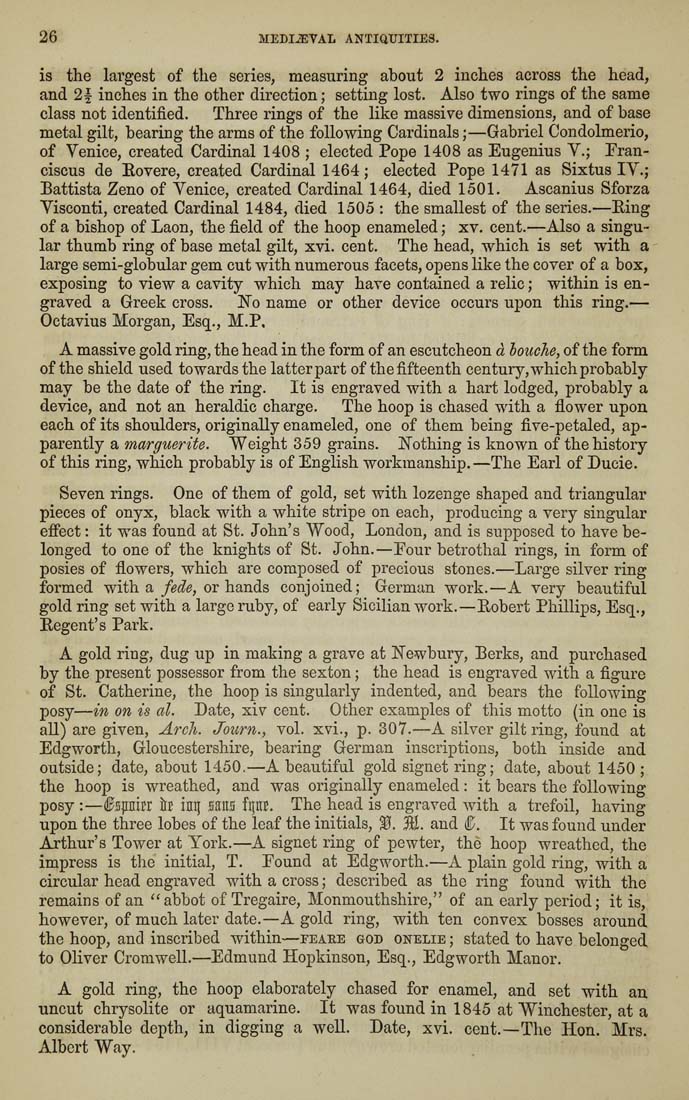26
MEDIEVAL antiquities.
is the largest of the series, measuring about 2 inches across the head,
and 2f inches in the other direction; setting lost. Also two rings of the same
class not identified. Three rings of the like massive dimensions, and of base
metal gilt, bearing the arms of the following Cardinals;—Gabriel Condolmerio,
of Venice, created Cardinal 1408 ; elected Pope 1408 as Eugenius V.; Fran-
ciscus de Rovere, created Cardinal 1464; elected Pope 1471 as Sixtus IV.;
Battista Zeno of Venice, created Cardinal 1464, died 1501. Ascanius Sforza
Visconti, created Cardinal 1484, died 1505 : the smallest of the series.—Ring
of a bishop of Laon, the field of the hoop enameled; xv. cent.—Also a singu¬
lar thumb ring of base metal gilt, xvi. cent. The head, which is set with a
large semi-globular gem cut with numerous facets, opens like the cover of a box,
exposing to view a cavity which may have contained a relic; within is en¬
graved a Greek cross. No name or other device occurs upon this ring.—
Octavius Morgan, Esq., M.P.
A massive gold ring, the head in the form of an escutcheon d bouche, of the form
of the shield used towards the latter part of the fifteenth century, which probably
may be the date of the ring. It is engraved with a hart lodged, probably a
device, and not an heraldic charge. The hoop is chased with a flower upon
each of its shoulders, originally enameled, one of them being five-petaled, ap¬
parently a marguerite. Weight 359 grains. Nothing is known of the history
of this ring, which probably is of English workmanship. —The Earl of Ducie.
Seven rings. One of them of gold, set with lozenge shaped and triangular
pieces of onyx, black with a white stripe on each, producing a very singular
effect: it was found at St. John's Wood, London, and is supposed to have be¬
longed to one of the knights of St. John.—Four betrothal rings, in form of
posies of flowers, which are composed of precious stones.—Large silver ring
formed with a fede, or hands conjoined; German work.—A very beautiful
gold ring set with a large ruby, of early Sicilian work.—Robert Phillips, Esq.,
Regent's Park.
A gold ring, dug up in making a grave at Newbury, Berks, and purchased
by the present possessor from the sexton; the head is engraved with a figure
of St. Catherine, the hoop is singularly indented, and bears the following
posy—in on is al. Date, xiv cent. Other examples of this motto (in one is
all) are given, Arch. Journ., vol. xvi., p. 307.—A silver gilt ring, found at
Edgworth, Gloucestershire, bearing German inscriptions, both inside and
outside; date, about 1450.—A beautiful gold signet ring; date, about 1450 ;
the hoop is wreathed, and was originally enameled: it bears the following
posy :—fepitt iTB int| nn fiptl. The head is engraved with a trefoil, having
upon the three lobes of the leaf the initials, %. M. and 6. It was found under
Arthur's Tower at York.—A signet ring of pewter, the hoop wreathed, the
impress is the" initial, T. Found at Edgworth.—A plain gold ring, with a
circular head engraved with a cross; described as the ring found with the
remains of an " abbot of Tregaire, Monmouthshire," of an early period; it is,
however, of much later date.—A gold ring, with ten convex bosses around
the hoop, and inscribed within—feare god onelie ; stated to have belonged
to Oliver Cromwell.—Edmund Hopkinson, Esq., Edgworth Manor.
A gold ring, the hoop elaborately chased for enamel, and set with an
uncut chrysolite or aquamarine. It was found in 1845 at Winchester, at a
considerable depth, in digging a well. Date, xvi. cent.—The Hon. Mrs
Albert Way.
|








